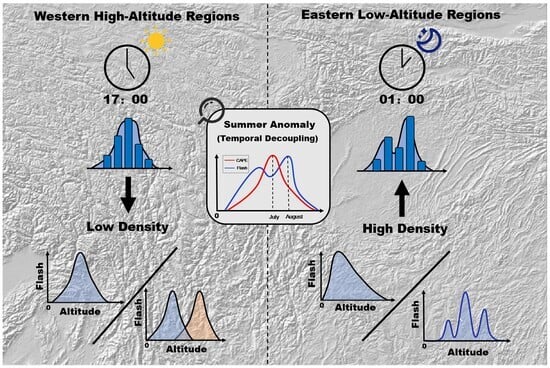A Comparative Analysis of CG Lightning Activities in the Hengduan Mountains and Its Surrounding Areas
Highlights
- A stark east–west dichotomy governs the regional lightning climatology; the eastern basin and plateau are characterized by high lightning density and nocturnal peaks, contrasting with the lower density and afternoon maxima of the western high-altitude areas.
- The relationship between lightning frequency and altitude is highly region-specific, exhibiting unique patterns that directly reflect the distinct topography of each of the four sub-regions studied.
- A “summer anomaly” is observed, defined as a temporal decoupling where the seasonal peak in lightning activity does not coincide with the peak in its thermodynamic driver (CAPE).
- The stark east–west divide implies that different large-scale atmospheric circulation patterns are the dominant controls, requiring distinct forecasting strategies for eastern and western regions.
- The highly customized, topographically-driven altitude patterns demonstrate that local terrain forcing is critical for convective initiation, highlighting the necessity of high-resolution models for accurate lightning prediction in these areas.
- The discovery of the “summer anomaly” reveals that thermodynamic indices alone are insufficient for seasonal prediction; models must also incorporate the evolving efficiency of cloud microphysical and electrification processes to capture lightning peaks accurately.
Abstract
1. Introduction
2. Data and Methods
2.1. Region of Interest
2.2. Data Source
2.3. Data Processing
3. Results
3.1. Distribution Characteristics of CG Lightning Activities
3.1.1. Spatial Distribution
3.1.2. Temporal Distribution
3.2. Analysis of Influencing Factors
3.2.1. Meteorological Elements
3.2.2. Altitude and Topography Factors
4. Discussion
Author Contributions
Funding
Data Availability Statement
Acknowledgments
Conflicts of Interest
References
- Moris, J.V.; Conedera, M.; Nisi, L.; Bernardi, M.; Cesti, G.; Pezzatti, G.B. Lightning-caused fires in the Alps: Identifying the igniting strokes. Agric. For. Meteorol. 2020, 290, 107990. [Google Scholar] [CrossRef]
- Müller, M.M.; Vacik, H. Characteristics of lightnings igniting forest fires in Austria. Agric. For. Meteorol. 2017, 240–241, 26–34. [Google Scholar] [CrossRef]
- Zhu, J. Comparison of the satellite-based Lightning Imaging Sensor (LIS) against the ground-based national lightning monitoring network. Prog. Geophys. 2018, 33, 541–546. [Google Scholar] [CrossRef]
- Xu, M.; Qie, X.; Pang, W.; Shi, G.; Liang, L.; Sun, Z.; Yuan, S.; Zhu, K.; Zhao, P. Lightning climatology across the Chinese continent from 2010 to 2020. Atmos. Res. 2022, 275, 106251. [Google Scholar] [CrossRef]
- Blakeslee, R.J.; Christian, H.J.; Mach, D.M.; Virts, K.S.; Buechler, D.E.; Walker, T.D.; Koshak, W.J.; Ellett, W.T.; Stewart, M.F. Lightning Imaging Sensor on the International Space Station: Assessments and results from first year operations [Paper presentation]. In Proceedings of the XVI International Conference on Atmospheric Electricity, Nara, Japan, 17–22 June 2018. [Google Scholar]
- Salvador, A.; Pineda, N.; Montanyà, J.; López, J.A.; Solà, G. Thunderstorm charge structures favouring cloud-to-ground lightning. Atmos. Res. 2021, 257, 105577. [Google Scholar] [CrossRef]
- Barman, S.D.; Shah, R.; Islam, S.; Kumar, A. Numerical Model of Cloud-to-Ground Lightning for PyroCb Thunderstorms. IEEE J. Sel. Top. Appl. Earth Obs. Remote Sens. 2023, 16, 8689–8701. [Google Scholar] [CrossRef]
- Yang, X.; Sun, J.; Li, W. An Analysis of Cloud-to-Ground Lightning in China during 2010–13. Weather Forecast. 2015, 30, 1537–1550. [Google Scholar] [CrossRef]
- Yuan, T.; Qie, X. Spatial and Temporal Distributions of Lightning Activities in China from Satellite Observation. Plateau Meteorol. 2004, 23, 488–494. [Google Scholar]
- Matsui, M.; Michishita, K.; Yokoyama, S. Cloud-to-ground lightning flash density and the number of lightning flashes hitting wind turbines in Japan. Electr. Power Syst. Res. 2020, 181, 106066. [Google Scholar] [CrossRef]
- Matsangouras, I.T.; Nastos, P.T.; Kapsomenakis, J. Cloud-to-ground lightning activity over Greece: Spatio-temporal analysis and impacts. Atmos. Res. 2016, 169, 485–496. [Google Scholar] [CrossRef]
- Enno, S.E. A climatology of cloud-to-ground lightning over Estonia, 2005–2009. Atmos. Res. 2011, 100, 310–317. [Google Scholar] [CrossRef]
- Yusop, N.; Ahmad, M.R.; Abdullah, M.; Zainudin, S.K.; Nor, W.N.A.W.M.; Alhasa, K.M.; Esa, M.R.M.; Sabri, M.H.M.; Suparta, W.; Gulisano, A.M.; et al. Cloud-to-Ground lightning observations over the Western Antarctic region. Polar Sci. 2019, 20, 84–91. [Google Scholar] [CrossRef]
- Tinmaker, M.I.R.; Dwivedi, A.K.; Islam, S.; Ghude, S.D.; Kulkarni, S.H.; Khare, M.; Chate, D.M. Lightning Activity Variability with Prevailing Weather Parameters and Aerosol Loading Over Dry and Wet Regions of India. Pure Appl. Geophys. 2021, 178, 1445–1457. [Google Scholar] [CrossRef]
- Chate, D.M.; Tinmaker, M.I.R.; Aslam, M.Y.; Ghude, S.D. Climate indicators for lightning over sea, sea–land mixed and land-only surfaces in India. Int. J. Climatol. 2016, 37, 1672–1679. [Google Scholar] [CrossRef]
- Qie, K.; Qie, X.; Tian, W. Increasing trend of lightning activity in the South Asia region. Sci. Bull. 2021, 66, 78–84. [Google Scholar] [CrossRef] [PubMed]
- Bourscheidt, V.; Pinto, O.; Naccarato, K.P.; Pinto, I.R.C.A. The influence of topography on the cloud-to-ground lightning density in South Brazil. Atmos. Res. 2009, 91, 508–513. [Google Scholar] [CrossRef]
- Soula, S.; Kasereka, J.K.; Georgis, J.F.; Barthe, C. Lightning climatology in the Congo Basin. Atmos. Res. 2016, 178–179, 304–319. [Google Scholar] [CrossRef]
- Wasswa, P.; Sabiiti, G.; Okal, H.; Kato, P.; Lunyolo, J.; Namulindwa, H. An Assessment of Spatio-Temporal Characteristics of Lightning Occurrence with Elevation, a Case of Uganda. Preprints 2021. [Google Scholar] [CrossRef]
- Qi, W.; Zhang, B.; Pang, Y.; Zhao, F.; Zhang, S. TRMM-Data-Based Spatial and Seasonal Patterns of Precipitation in the Qinghai-Tibet Plateau. Sci. Geol. Sin. 2013, 33, 999–1005. [Google Scholar] [CrossRef]
- Renfrew, I.A.; Elvidge, A.D. The Causes of Foehn Warming in the Lee of Mountains. Bull. Am. Meteorol. Soc. 2016, 97, 455–466. [Google Scholar] [CrossRef]
- Qie, X.; Qie, K.; Wei, L.; Zhu, K.; Sun, Z.; Yuan, S.; Jiang, R.; Zhang, H.; Xu, C. Significantly Increased Lightning Activity Over the Tibetan Plateau and Its Relation to Thunderstorm Genesis. Geophys. Res. Lett. 2022, 49, e2022GL099894. [Google Scholar] [CrossRef]
- Qie, X.; Yuan, T.; Xie, Y.; Ma, Y. Spatial and temporal distribution of lightning activities over the Tibetan plateau. Chin. J. Geophys. 2004, 47, 997–1002. [Google Scholar] [CrossRef]
- Qie, X.; Wei, L.; Zhu, K.; Qie, K.; Xu, C.; Sun, Z.; Jiang, R.; Zhang, H.; Yuan, S. Regional differences of convection structure of thunderclouds over the Tibetan Plateau. Atmos. Res. 2022, 278, 106338. [Google Scholar] [CrossRef]
- Li, Y.D.; Wang, Y.; Song, Y.; Hu, L.; Gao, S.T.; Rong, F. Characteristics of Summer Convective Systems Initiated over the Tibetan Plateau. Part I: Origin, Track, Development, and Precipitation. J. Appl. Meteorol. Climatol. 2008, 47, 2679–2695. [Google Scholar] [CrossRef]
- Wang, H.; Tan, Y.; Shi, Z.; Yang, N.; Zheng, T. Diurnal differences in the effect of aerosols on cloud-to-ground lightning in the Sichuan Basin. Atmos. Chem. Phys. 2023, 23, 2843–2857. [Google Scholar] [CrossRef]
- Xia, R.; Zhang, D.-L.; Wang, B. A 6-yr Cloud-to-Ground Lightning Climatology and Its Relationship to Rainfall over Central and Eastern China. J. Appl. Meteorol. Climatol. 2015, 54, 2443–2460. [Google Scholar] [CrossRef]
- Liu, Y.; Jiang, Y.; Gao, Q.; Shi, Z.; Jiang, Z.; Hu, J. Characteristic analysis of lightning activities on the Yungui Plateau using ground-based remote sensing. Front. Environ. Sci. 2022, 10, 949271. [Google Scholar] [CrossRef]
- Oulkar, S.; Siingh, D.; Saha, U.; Kamra, A.K. Distribution of lightning in relation to topography and vegetation cover over the dry and moist regions in the Himalayas. J. Earth Syst. Sci. 2019, 128, 180. [Google Scholar] [CrossRef]
- Qie, X.; Toumi, R.; Yuan, T. Lightning activities on the Tibetan Plateau as observed by the lightning imaging sensor. J. Geophys. Res. Atmos. 2003, 108, 4551. [Google Scholar] [CrossRef]
- Zhao, P.; Li, Z.; Xiao, H.; Wu, F.; Zheng, Y.; Cribb, M.C.; Jin, X.; Zhou, Y. Distinct aerosol effects on cloud-to-ground lightning in the plateau and basin regions of Sichuan, Southwest China. Atmos. Chem. Phys. 2020, 20, 13379–13397. [Google Scholar] [CrossRef]
- Li, J.; Wu, X.; Yang, J.; Jiang, R.; Yuan, T.; Lu, J.; Sun, M. Lightning activity and its association with surface thermodynamics over the Tibetan Plateau. Atmos. Res. 2020, 245, 105118. [Google Scholar] [CrossRef]
- Shi, Z.; Hu, J.; Tan, Y.; Guo, X.; Wang, H.; Guan, X.; Wu, Z. Significant influence of aerosol on cloud-to-ground lightning in the Sichuan Basin. Atmos. Res. 2022, 278, 106330. [Google Scholar] [CrossRef]
- Yin, L.Y.; Wang, H.Y.; Jin, W.J.; Zhang, S.D.; Wang, W.G.; Mei, H. Lightning Activity Characteristics under Complex Topography in Low Latitude Plateau of China. Appl. Ecol. Environ. Res. 2018, 16, 6349–6367. [Google Scholar] [CrossRef]
- Horton, P. Analogue methods and ERA5: Benefits and pitfalls. Int. J. Climatol. 2021, 42, 4078–4096. [Google Scholar] [CrossRef]
- Chriest, J. Meteorological Drivers of Lightning in Alaska on Seasonal and Sub-Seasonal Timescales. Master’s Thesis, University of Alaska Fairbanks, Fairbanks, AK, USA, 2021. [Google Scholar]
- Yilmaz, M. Accuracy assessment of temperature trends from ERA5 and ERA5-Land. Sci. Total Environ. 2023, 856 Pt 2, 159182. [Google Scholar] [CrossRef]
- Lavers, D.A.; Simmons, A.; Vamborg, F.; Rodwell, M.J. An evaluation of ERA5 precipitation for climate monitoring. Q. J. R. Meteorol. Soc. 2022, 148, 3152–3165. [Google Scholar] [CrossRef]
- Jiang, Q.; Li, W.; Fan, Z.; He, X.; Sun, W.; Chen, S.; Wen, J.; Gao, J.; Wang, J. Evaluation of the ERA5 reanalysis precipitation dataset over Chinese Mainland. J. Hydrol. 2021, 595, 125660. [Google Scholar] [CrossRef]
- Hersbach, H.; Bell, B.; Berrisford, P.; Hirahara, S.; Horányi, A.; Muñoz--Sabater, J.; Nicolas, J.; Peubey, C.; Radu, R.; Schepers, D.; et al. The ERA5 global reanalysis. Q. J. R. Meteorol. Soc. 2020, 146, 1999–2049. [Google Scholar] [CrossRef]
- Pinto, O.; Regina, C.A.; Pinto, I.H.; Diniz, J.; Cazetta Filho, A.C.L.; Cherchiglia, L.M.; Carvalho, A. A seven-year study about the negative cloud-to-ground lightning flash characteristics in Southeastern Brazil. J. Atmos. Sol. Terr. Phys. 2003, 65, 739–748. [Google Scholar] [CrossRef]
- Wang, J.; Chen, Y. Analysis of the 2009-2012 Lightning Distribution Characteristics in China. Meteorol. Mon. 2015, 41, 160–170. [Google Scholar] [CrossRef]
- Ma, M.; Tao, S.; Zhu, B.; LÜ, W. Climatological distribution of lightning density observed by satellites in China and its circumjacent regions. Sci. China Ser. D Earth Sci. 2005, 48, 219–229. [Google Scholar] [CrossRef]
- Qie, X.; Yu, Y.; Wang, D.; Wang, H.; Chu, R. Characteristics of Cloud-to-Ground Lightning in Chinese Inland Plateau. J. Meteorol. Soc. Jpn. 2002, 80, 745–754. [Google Scholar] [CrossRef]
- Ma, R.; Zheng, D.; Zhang, Y.; Yao, W.; Zhang, W.; Cuomu, D. Spatiotemporal Lightning Activity Detected by WWLLN over the Tibetan Plateau and Its Comparison with LIS Lightning. J. Atmos. Ocean. Technol. 2021, 38, 511–523. [Google Scholar] [CrossRef]
- Zhao, P.; Zhang, Y.; Liu, C.; Zhang, P.; Xiao, H.; Zhou, Y. Potential Relationship Between Aerosols and Positive Cloud-to-Ground Lightning During the Warm Season in Sichuan, Southwest China. Front. Environ. Sci. 2022, 10, 945100. [Google Scholar] [CrossRef]
- Whiteman, C.D.; Dreiseitl, E. (Eds.) Alpine Meteorology: Translations of Classic Contributions by A. Wagner, E. Ekhart, and F. Defant; Report No. PNL-5141, ASCOT-84-3; Pacific Northwest Laboratory: Richland, WA, USA, 1984.
- Richard, T.; McNider, R.A.P. Diurnal Boundary-Layer Development over Sloping Terrain. J. Atmos. Sci. 1981, 38, 2198–2212. [Google Scholar] [CrossRef]
- Toumi, R.; Qie, X. Seasonal variation of lightning on the Tibetan Plateau: A Spring anomaly? Geophys. Res. Lett. 2004, 31, L04115. [Google Scholar] [CrossRef]
- Williams, E.; Stanfill, S. The physical origin of the land-ocean contrast in lightning activity. Comptes Rendus Phys. 2002, 3, 1277–1292. [Google Scholar] [CrossRef]
- Wu, Z.; Guo, F.; Lu, X.; Liu, Z.; Deng, J.; Chen, K.; Wang, Q. Simulation on Effect of Updrafts on Complexity of Charge Structures in Thunderstorm Clouds. Chin. J. Atmos. Sci. 2025, 49, 153–172. [Google Scholar] [CrossRef]
- Xu, W. Precipitation and Convective Characteristics of Summer Deep Convection over East Asia Observed by TRMM. Mon. Weather Rev. 2013, 141, 1577–1592. [Google Scholar] [CrossRef]
- Zhao, P.; Xiao, H.; Liu, C.; Zhou, Y.; Karacostas, T. Dependence of Warm Season Cloud-to-Ground Lightning Polarity on Environmental Conditions over Sichuan, Southwest China. Adv. Meteorol. 2021, 2021, 1500470. [Google Scholar] [CrossRef]
- Zhang, Y.; Xue, M.; Zhu, K.; Zhou, B. What is the main cause of diurnal variation and nocturnal peak of summer precipitation in Sichuan Basin, China? The key role of boundary layer low-level jet inertial oscillations. J. Geophys. Res. Atmos. 2019, 124, 2643–2664. [Google Scholar] [CrossRef]
- Hu, Y.; Tao, S.; Gong, M.; Ma, H. Influence analysis of geographic parameters on lightning in plateau. Arid. Land Geogr. 2022, 45, 746–753. [Google Scholar] [CrossRef]
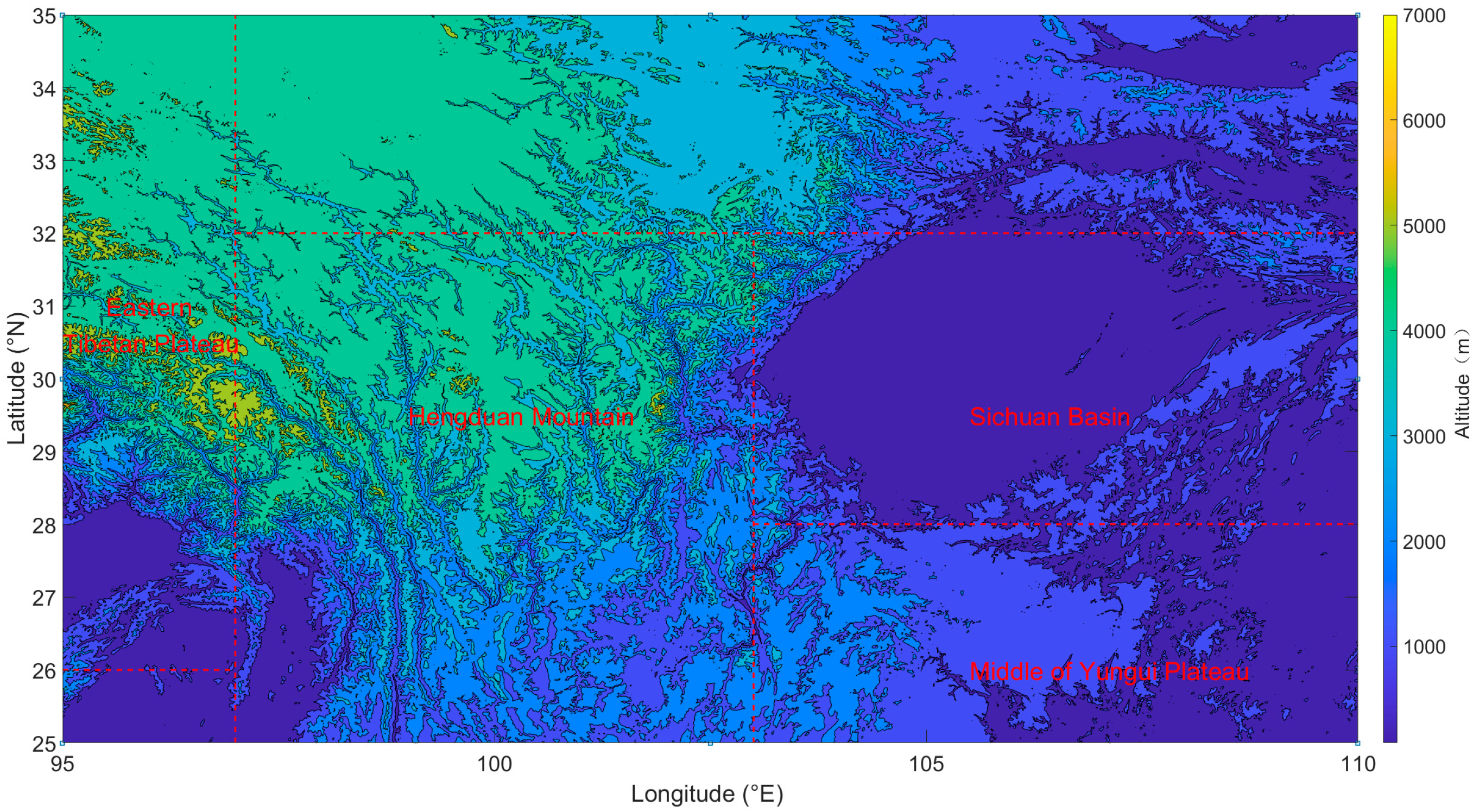
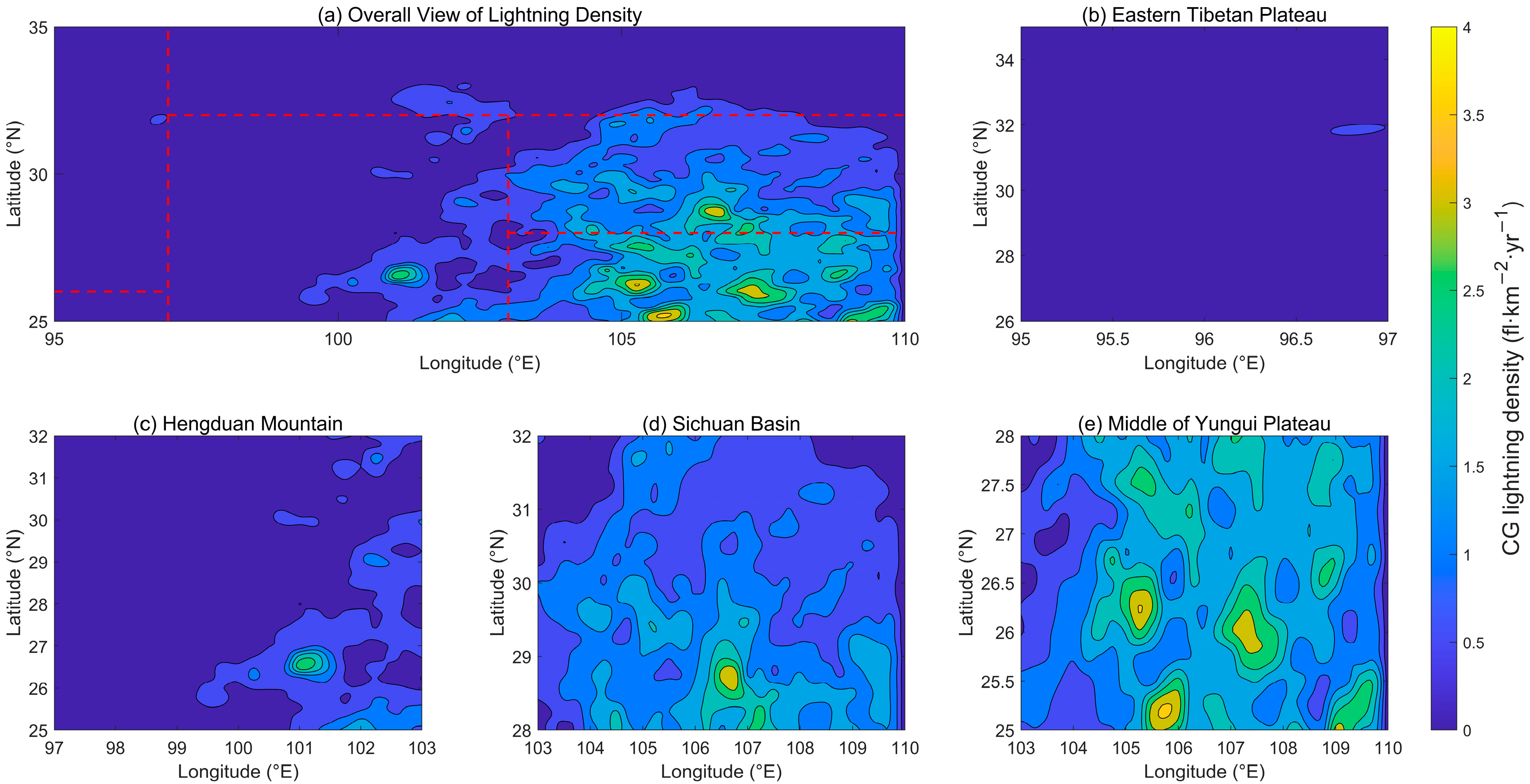
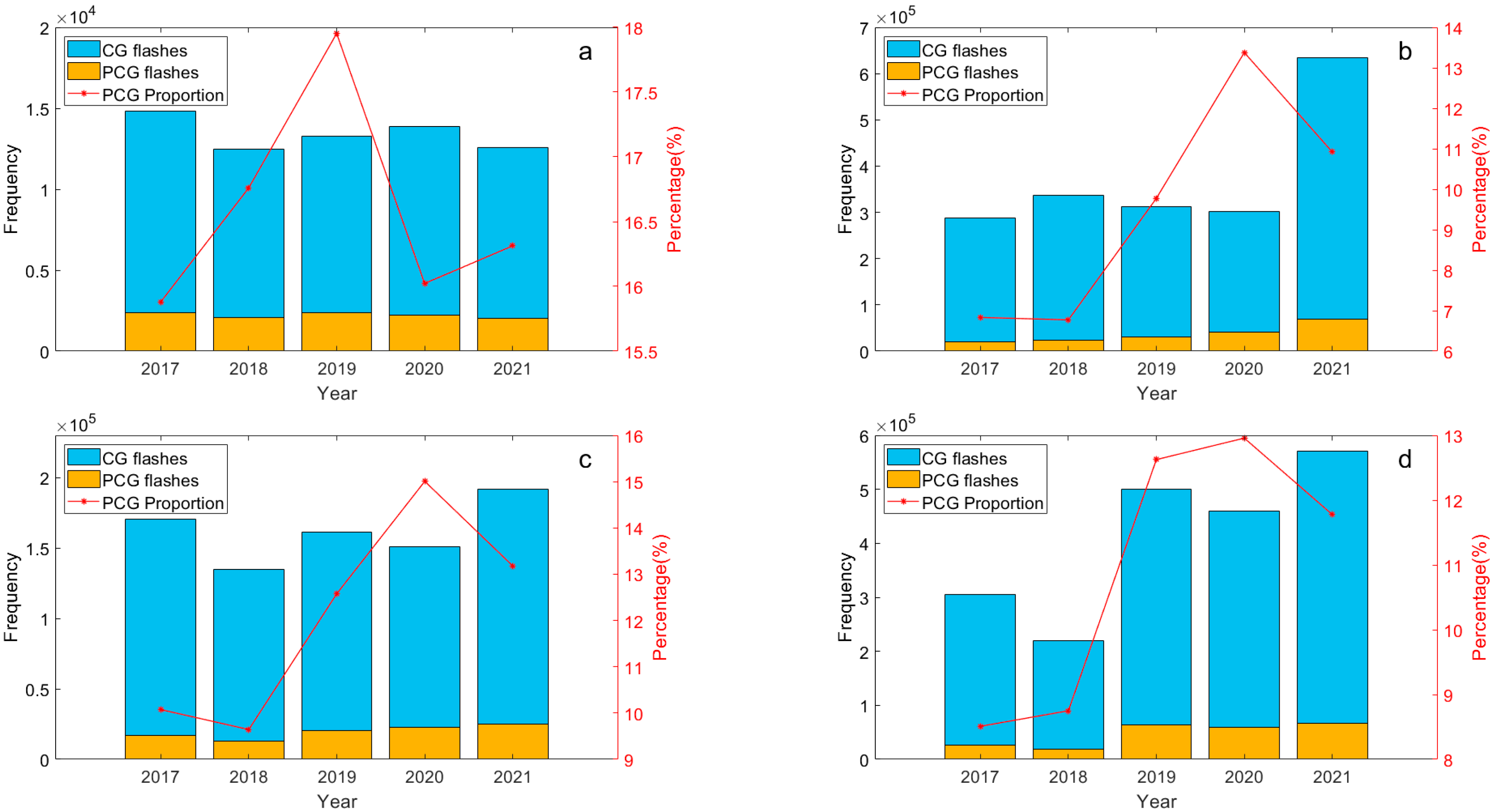

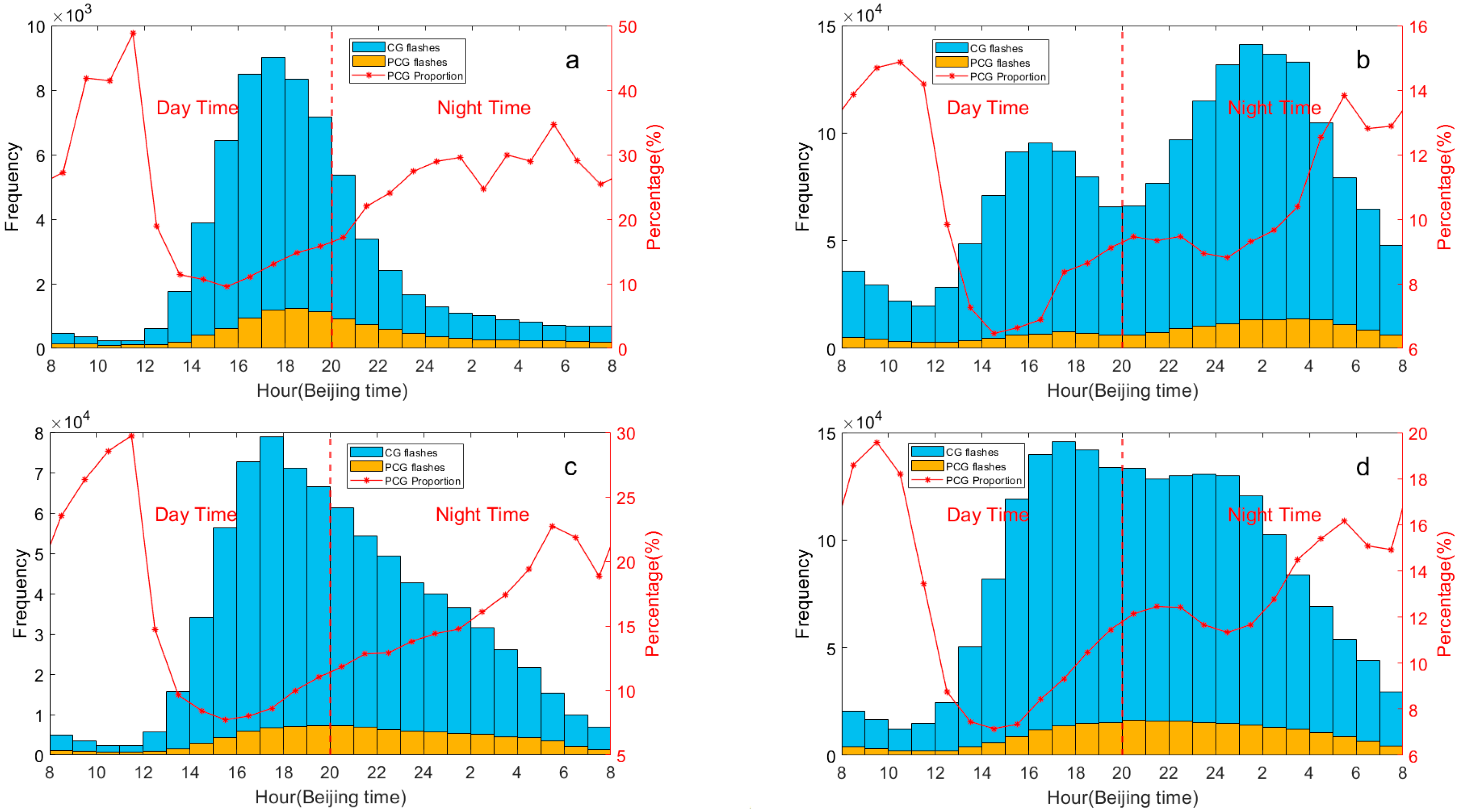
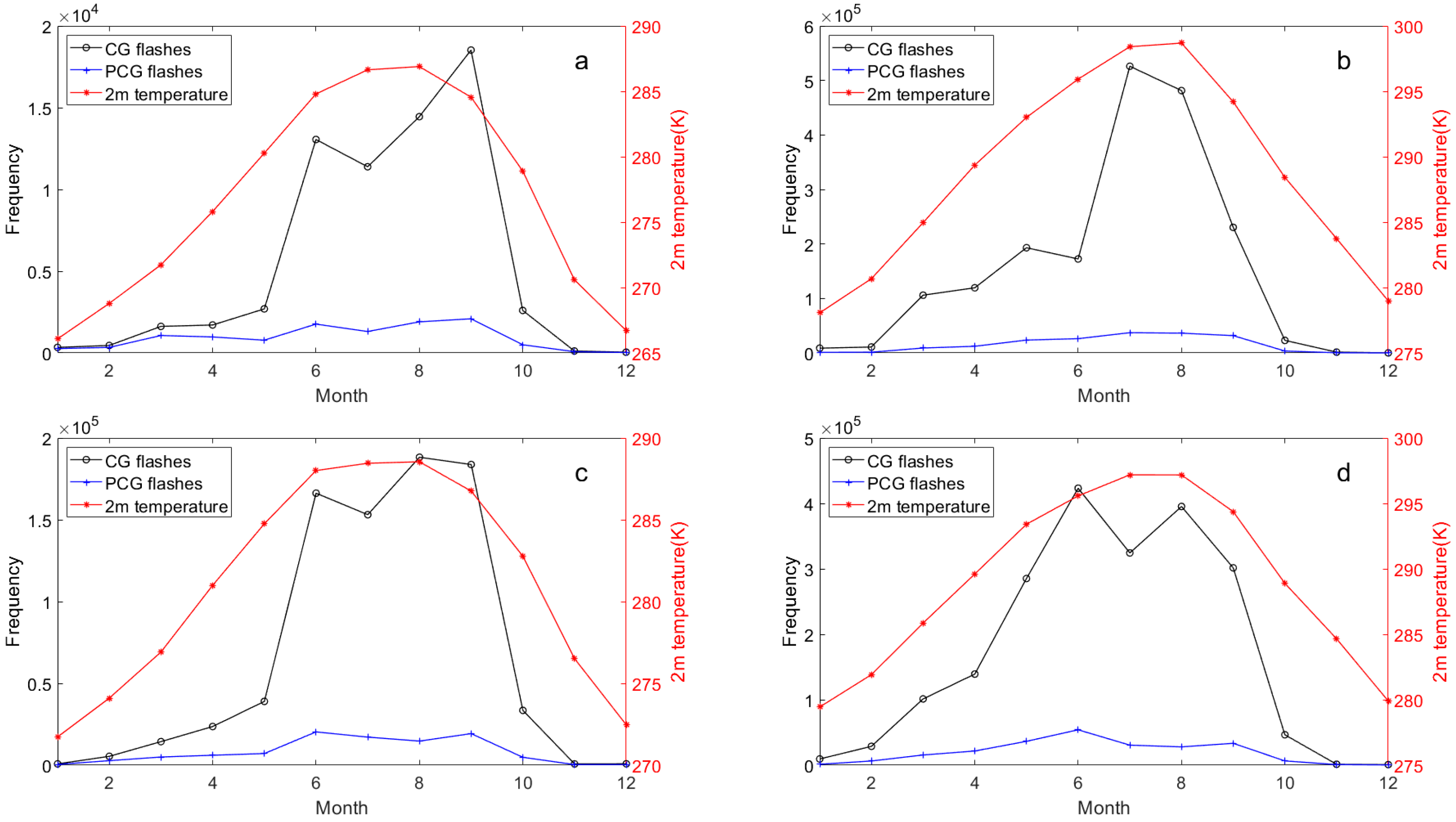
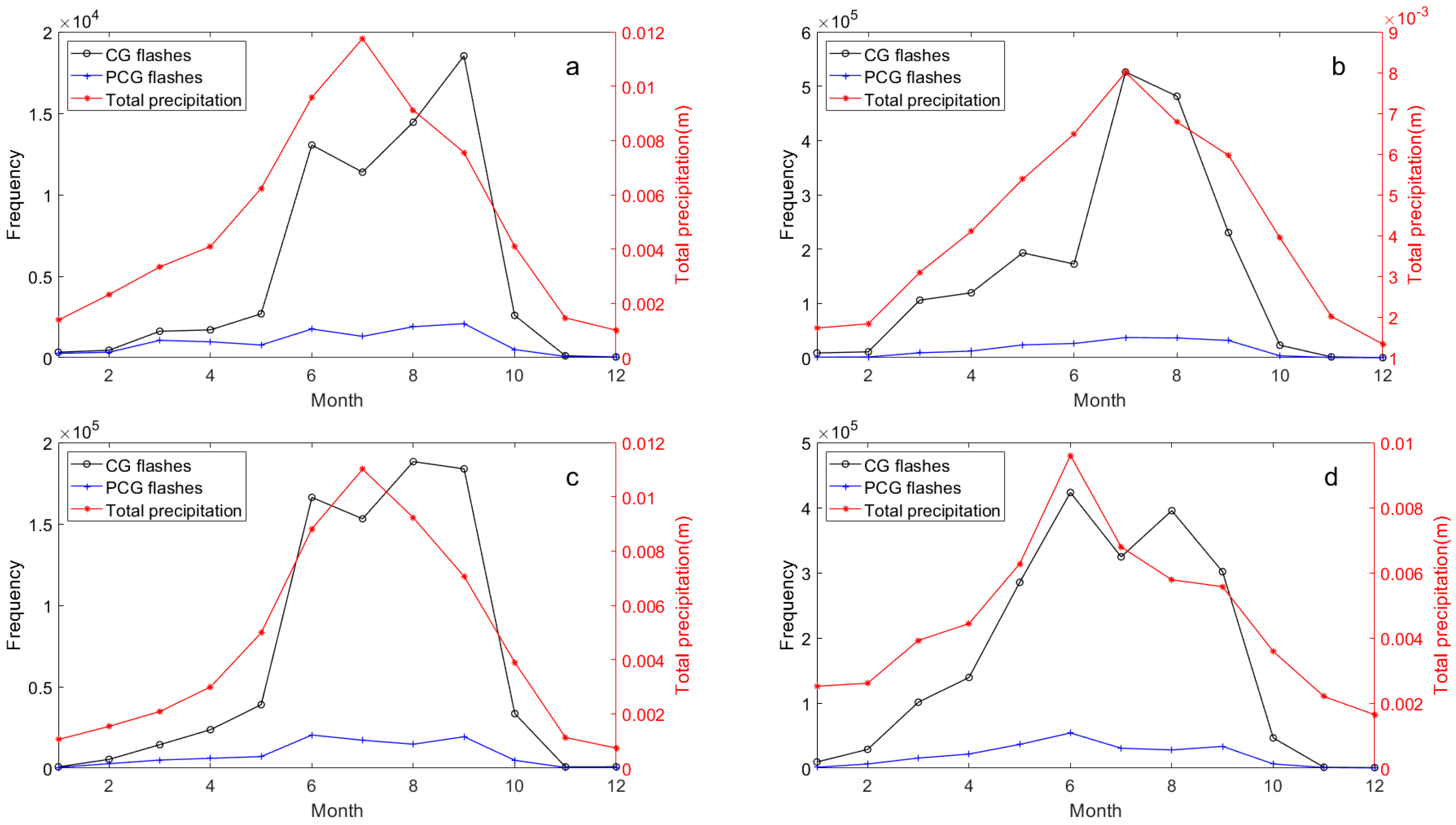
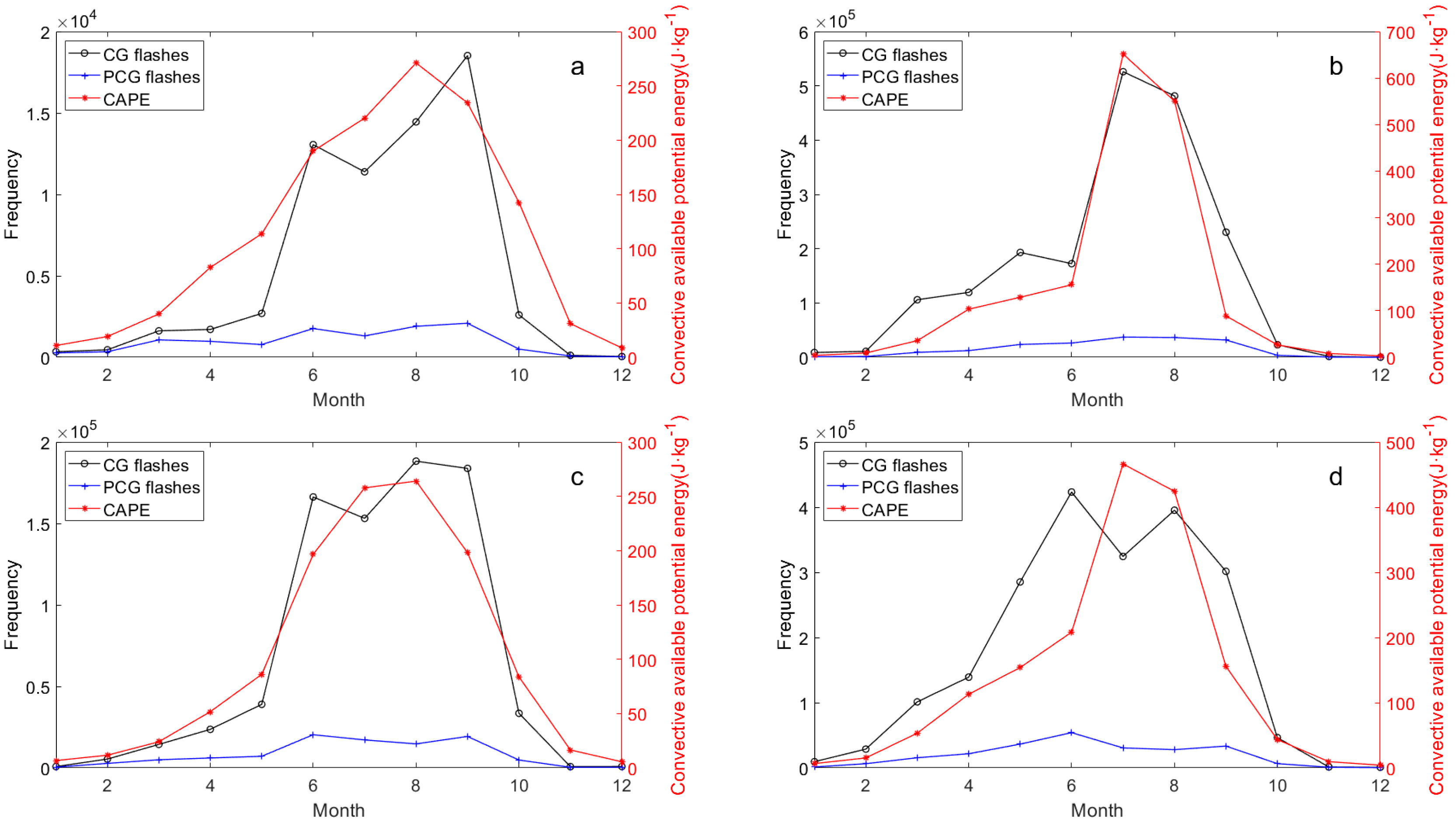
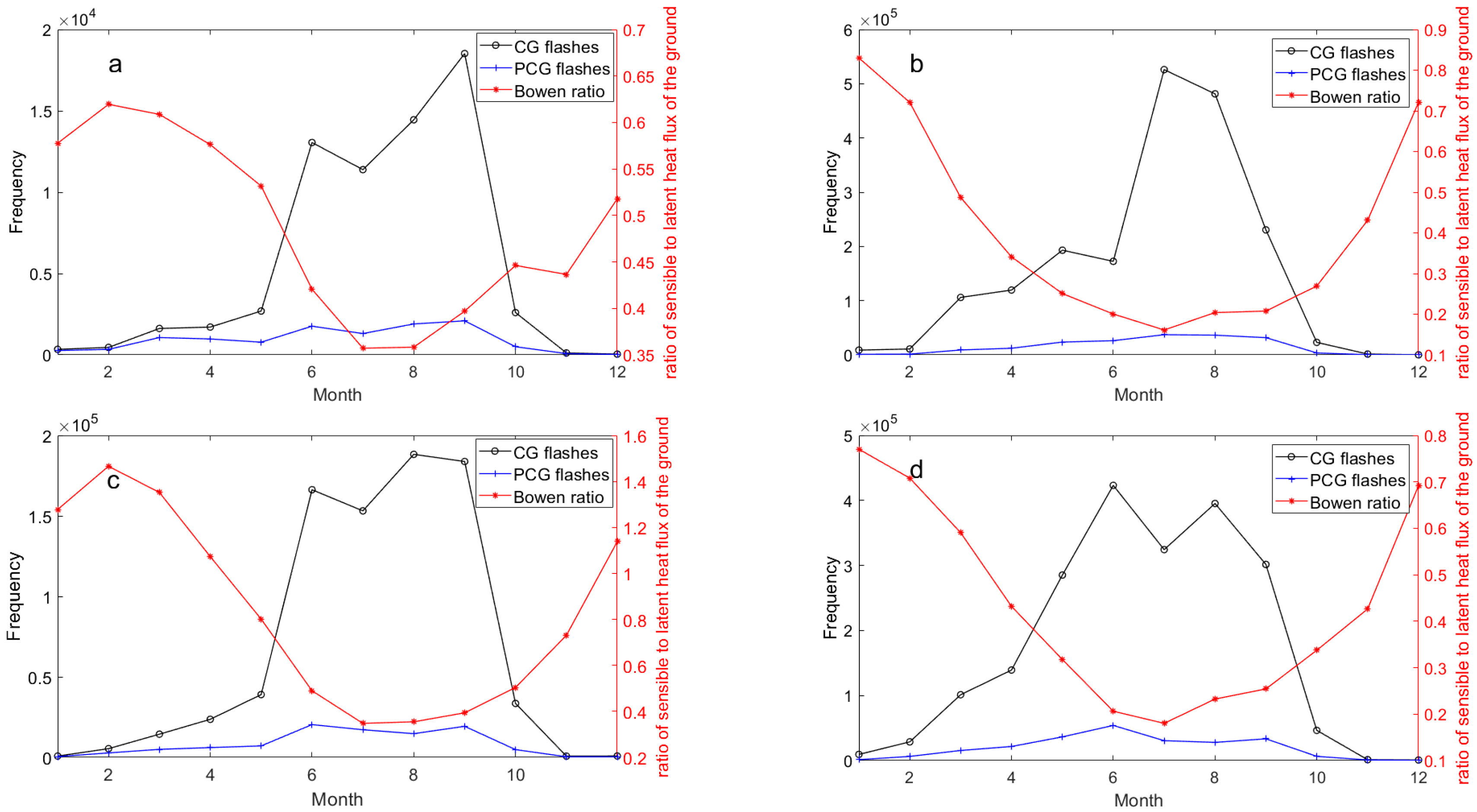
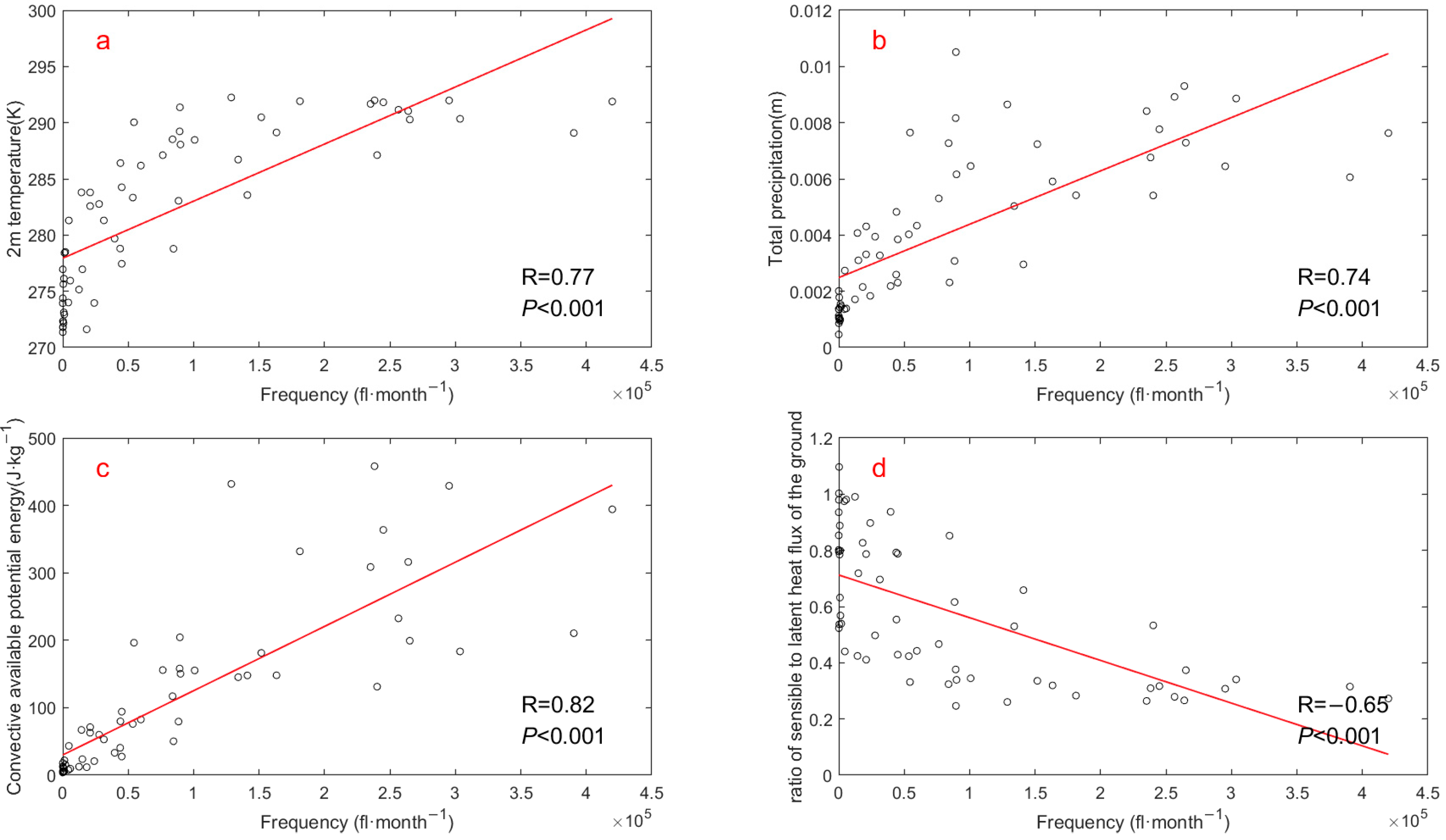
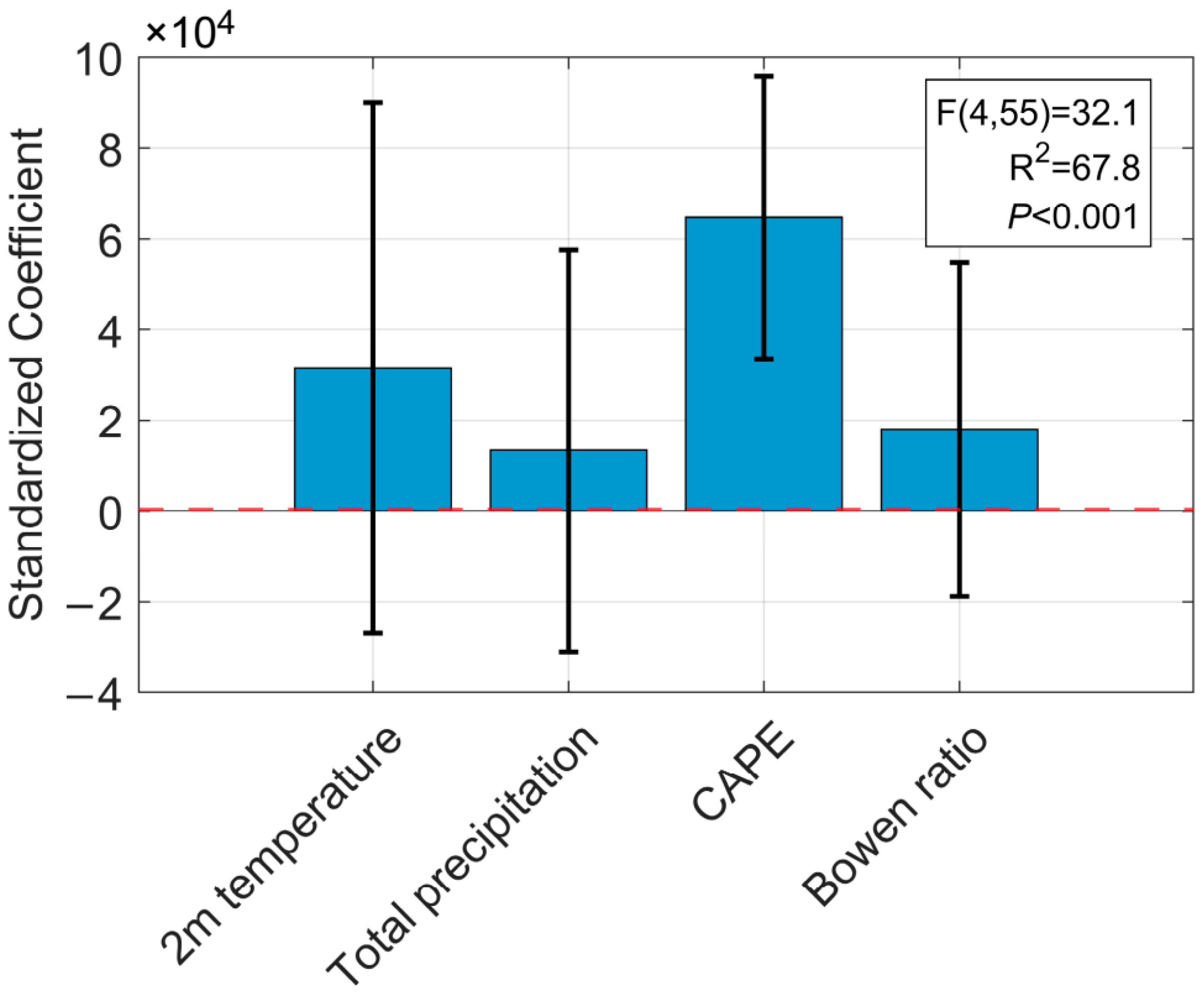
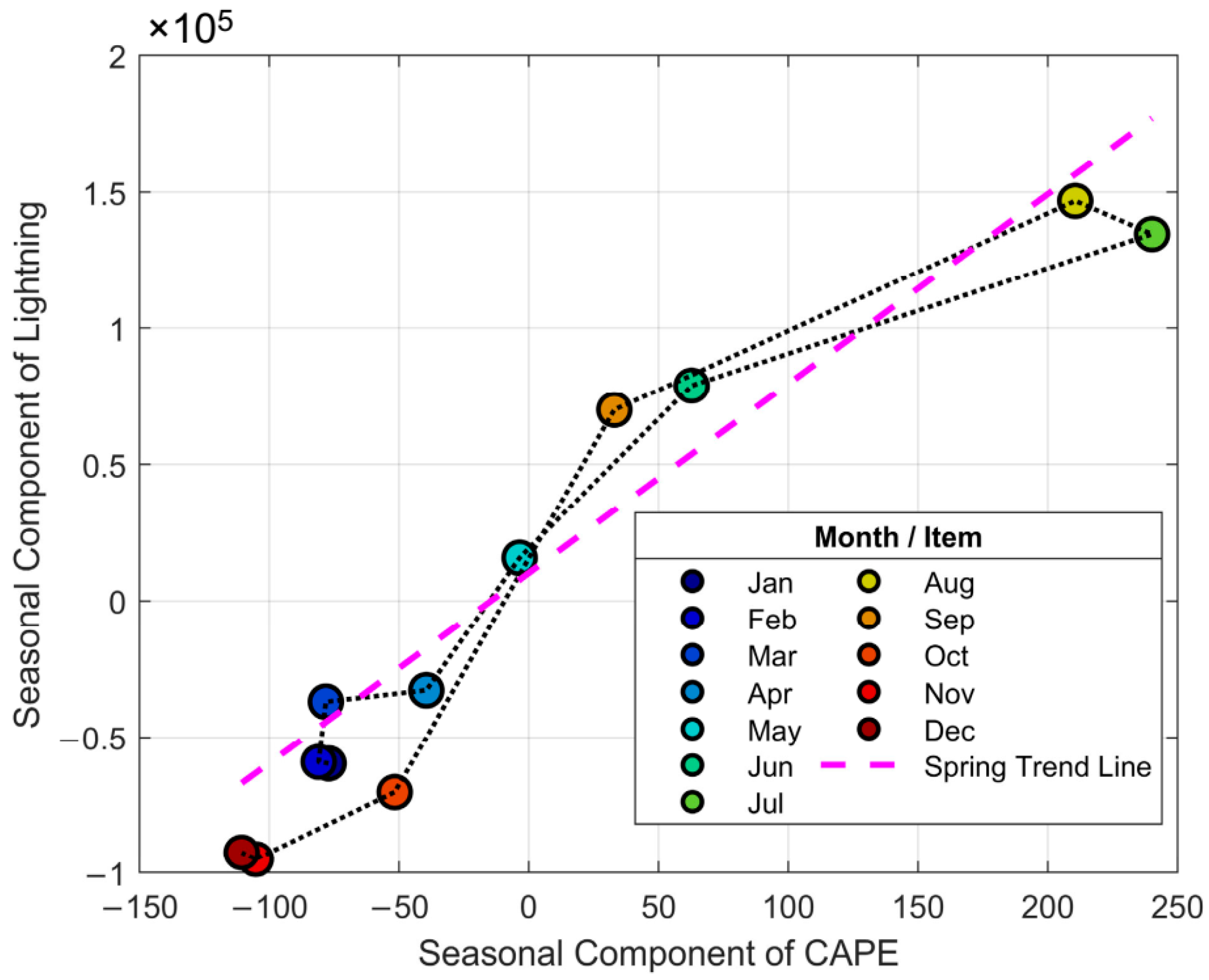

| Proportion (%) | Eastern Tibetan Plateau | Sichuan Basin | Hengduan Mountain | Middle of Yungui Plateau |
|---|---|---|---|---|
| Night flashes to total flashes | 29.87 | 63.75 | 48.85 | 56.20 |
| Night positive flashes to total positive flashes | 43.03 | 67.45 | 59.33 | 62.88 |
| Night negative flashes to total negative flashes | 27.26 | 63.35 | 47.40 | 55.33 |
Disclaimer/Publisher’s Note: The statements, opinions and data contained in all publications are solely those of the individual author(s) and contributor(s) and not of MDPI and/or the editor(s). MDPI and/or the editor(s) disclaim responsibility for any injury to people or property resulting from any ideas, methods, instructions or products referred to in the content. |
© 2025 by the authors. Licensee MDPI, Basel, Switzerland. This article is an open access article distributed under the terms and conditions of the Creative Commons Attribution (CC BY) license (https://creativecommons.org/licenses/by/4.0/).
Share and Cite
Zhao, J.; Liu, Y.; Jiang, Y.; Tan, Y.; Shi, Z.; Zhao, Y.; Liu, J. A Comparative Analysis of CG Lightning Activities in the Hengduan Mountains and Its Surrounding Areas. Remote Sens. 2025, 17, 3574. https://doi.org/10.3390/rs17213574
Zhao J, Liu Y, Jiang Y, Tan Y, Shi Z, Zhao Y, Liu J. A Comparative Analysis of CG Lightning Activities in the Hengduan Mountains and Its Surrounding Areas. Remote Sensing. 2025; 17(21):3574. https://doi.org/10.3390/rs17213574
Chicago/Turabian StyleZhao, Jingyue, Yinping Liu, Yuhui Jiang, Yongbo Tan, Zheng Shi, Yang Zhao, and Junjian Liu. 2025. "A Comparative Analysis of CG Lightning Activities in the Hengduan Mountains and Its Surrounding Areas" Remote Sensing 17, no. 21: 3574. https://doi.org/10.3390/rs17213574
APA StyleZhao, J., Liu, Y., Jiang, Y., Tan, Y., Shi, Z., Zhao, Y., & Liu, J. (2025). A Comparative Analysis of CG Lightning Activities in the Hengduan Mountains and Its Surrounding Areas. Remote Sensing, 17(21), 3574. https://doi.org/10.3390/rs17213574





